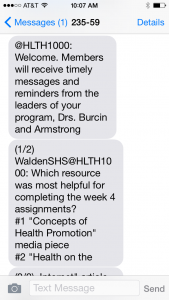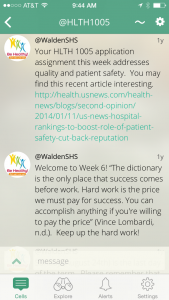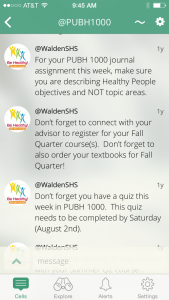Tags: Connectivism, Instructor Presence, Interaction, Social Media, Social Presence
Description
Use of mobile communication technology in the higher education setting is still a relatively new area of study. On brick and mortar campuses, students who have face-to-face interaction with their professors and peers can often be seen texting or “tweeting” between classes or in class. Such mobile messaging usage in class can be very distracting, but for online institutions use of social media tools within online classrooms may serve to mitigate factors that impact student persistence, and the student’s feeling of connection to the university, to the instructor, and to fellow students. According to Moore, Sener & Fetzner (2009), barriers to online success include students’ lack of motivation due to “impersonal, irrelevant, boring, one-size-fits-all page turners” (p. 87). In fact, Berge and Huang (2004) concluded that strengthening the relationships between bureaucratic, academic, social and external (life, work, family, and socioeconomic circumstances) interactions is critical to retention. Callaghan and Bower (2012) also showed that social media within the online courses led to an increase in the student’s level of activity within the online classroom. They also found that this higher level of activity was directly related to deeper levels of student satisfaction. The use of social media and other forms of mobile messaging tools could also be used to address access, learning effectiveness, and student satisfaction, which are three of the Online Learning Consortium’s (OLC) Five Pillars of Quality for Online Education (Online Learning Consortium, 2015).
Link to example artifact(s)
Celly is a free group mobile communication tool that instructors can use to send messages to students. Celly messages can be received on phones, tablets, email, and via the Celly website. The program coordinator for Walden University’s School of Health Sciences undergraduate programs sent out recruitment email announcements to undergraduate students enrolled in first-term foundation courses (PUBH 1000, HLTH 1000, HLTH 1005) over three, six-week terms (Spring Quarter 2, Summer Quarter 1 and Summer Quarter 2). An announcement about the messaging tool was also included in the announcement area within each online course. Students were informed that using Celly was free and optional; they could opt-out at any time, there was no monetary benefit, but participating provided them with enhanced opportunities for class reminders and program updates. Students were also assured that the decision not to join the Celly group would not result in any negative consequences to their course grade.
To participate, students were provided a specific number to text to officially enroll (e.g. text @PUBH1000 to #####). Text charges could apply, but there were applications (e.g. APPS) available without charge. Or students could simply use the Celly website connected to the group. Messages were pre-populated into the Celly website, relevant to each course’s weekly objectives and assignments, program updates, university services, or other health topics applicable. For example, a message reminding students that their first discussion posting was due on Thursday was sent out in week one of each course. Other messages highlighted live webinars being offered via the Career Services Center or Writing Center, academic integrity issues and resources, assistance with registering for courses, program of study guidelines, and national health month observances. Poll questions were also used, such as “Which of the following Writing Center resources did you find most helpful for completing the week 2 assignment?”
-
Text Message Example
-
Celly Web Example from HLTH 1005
-
Celly Web Example from PUBH 1000
Results from the Celly mobile messaging group survey noted that most students (83.8%) used their phone to receive the communication, while 40.5% used their computer and 5.4% used a tablet. 89.2% of students found it “very easy” or “easy” to set up their Celly accounts. In terms of message frequency (e.g. 1-2 messages/week), 74.3% responded they were just right and 25.7 noted there were too few. 60% of students “strongly agreed” or “agreed” that Celly texts made them feel more connected to their instructor” and 52% “strongly agreed” or “agreed” they felt more supported by their instructor. Finally, 82.8% of students indicated “strongly agree” or “agree” when asked if they would participate in Celly messaging in a future course. Qualitative feedback also supported the findings that students enjoyed their experience with Celly as a classroom communication tool.
Link to scholarly reference(s)
Berge, Z., & Huang, Y. (2004). A model for sustainable student-retention: a holistic perspective on the student dropout problem with special attention to e-learning. American Center for the Study of Distance Education, 13(5). Retrieved from http://www.westga.edu/~distance/ojdla/winter94/herbert94.htm
Bowers, J., & Kumar, P. (2015). Students’ perceptions of teaching and social presence: a comparative analysis of face-to-face and online learning environments. International Journal of Web-Based Learning and Teaching Technologies,10(1), p. 27-44.
Callaghan, N. & Bower, M. (2012). Learning through social networking sites: The critical role of the teacher. Educational Media International, 49(1), p. 1-17.
Moore, J. C., Sener, J., & Fetzner, M. (2009). Getting better: ALN and student success. Journal of Asynchronous Learning Networks, 13(3), 85-114.
Online Learning Consortium. (2015). OLC quality framework. Retrieved from http://onlinelearningconsortium.org/5-pillars/
Park, J.-H., & Choi, H. J. (2009). Factors influencing adult learners’ decision to drop out or persist in online learning. Educational Technology & Society, 12(4), 207–217.
Patterson, B., & McFadden, C. (2009). Attrition in online and campus degree programs. Online Journal of Distance Learning Administration, 12(2). Retrieved fromhttp://www.westga.edu/~distance/ojdla/summer122/patterson112.html
Rovai, A. P. (2003). In search of higher persistence rates in distance education online programs. Internet and Higher Education, 6, 1–16.
Citation
Armstrong, S. N., & Burcin, M. M. (2015). Use mobile communication technologies to increase students’ feelings of connectedness and instructor support. In B. Chen & K. Thompson (Eds.), Teaching Online Pedagogical Repository. Orlando, FL: University of Central Florida Center for Distributed Learning. https://topr.online.ucf.edu/use-mobile-communication-technologies-to-increase-students-feelings-of-connectedness-and-instructor-support/?rev=4862.Post Revisions:
- August 11, 2020 @ 17:19:28 [Current Revision]
- August 10, 2020 @ 20:14:35




